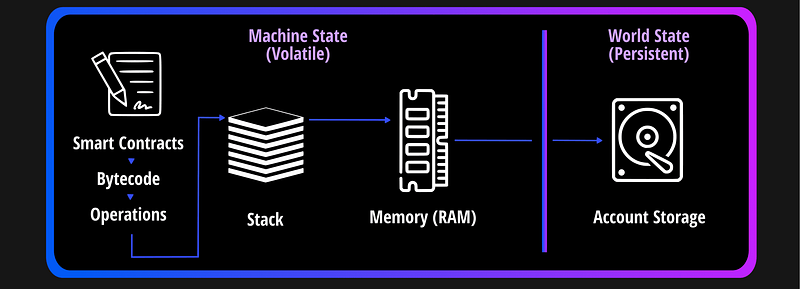Exploring Solidity Assembly: A Deep Dive into its Mechanism
As smart contracts become more complex, developers often need to optimize their code for efficiency, performance, and size. Solidity…

As smart contracts become more complex, developers often need to optimize their code for efficiency, performance, and size. Solidity Assembly comes to the rescue in such cases, allowing developers to write lower-level code directly.
Understanding Solidity Assembly
Solidity Assembly, also known as “inline assembly”, is a low-level language that allows developers to write code directly in the Ethereum Virtual Machine (EVM) bytecode. The EVM is the runtime environment for smart contracts on the Ethereum network, and it uses a stack-based architecture for executing code.
It is important to note that Assembly code is harder to write and read than Solidity code, requiring a deep understanding of the EVM architecture and opcodes.
How Solidity Assembly Works
Solidity Assembly code is embedded within a Solidity contract using the “assembly” keyword, followed by a code block. The Assembly code is then compiled into EVM bytecode alongside the rest of the Solidity code. This enables developers to optimize specific parts of their smart contracts while still benefiting from the convenience and readability of the high-level Solidity language.
Some of the key features of Solidity Assembly include:
- Opcodes: EVM opcodes are the basic instructions that the EVM executes. In Solidity Assembly, developers write opcodes to perform specific operations like arithmetic, logical operations, and storage manipulation.
Here are some of the most frequently used opcodes in Solidity Assembly:
ADD: This opcode adds the top two elements on the stack and pushes the result onto the stack. It is used for performing addition operations.
MUL: This opcode multiplies the top two elements on the stack and pushes the result onto the stack. It is used for performing multiplication operations.
SUB: This opcode subtracts the top element on the stack from the second-to-top element, then pushes the result onto the stack. It is used for performing subtraction operations.
DIV: This opcode divides the second-to-top element on the stack by the top element and pushes the result onto the stack. It is used for performing division operations.
MOD: This opcode calculates the remainder of the second-to-top element on the stack divided by the top element and pushes the result onto the stack. It is used for performing modulo operations.
LT, GT, EQ: These opcodes compare the top two elements on the stack and push the result onto the stack. LT (Less Than) checks if the second-to-top element is less than the top element, GT (Greater Than) checks if the second-to-top element is greater than the top element, and EQ (Equal) checks if the top two elements are equal.
AND, OR, XOR, NOT: These opcodes perform bitwise operations on the top elements of the stack. AND performs a bitwise AND operation, OR performs a bitwise OR operation, XOR performs a bitwise XOR operation, and NOT performs a bitwise NOT operation.
JUMP and JUMPI: These opcodes are used for control flow. JUMP transfers execution to the specified destination, while JUMPI conditionally jumps to the destination if the top element of the stack is non-zero.
DUPn and SWAPn: These opcodes are used for stack manipulation. DUPn (where n is an integer from 1 to 16) duplicates the nth stack element from the top and pushes it onto the stack, while SWAPn (where n is an integer from 1 to 16) swaps the top element of the stack with the nth element from the top.
SLOAD and SSTORE: These opcodes are used for contract storage manipulation. SLOAD reads a value from contract storage at a specified index and pushes it onto the stack, while SSTORE writes a value from the top of the stack to contract storage at a specified index.
MLOAD and MSTORE: These opcodes are used for memory manipulation. MLOAD reads a value from memory at a specified address and pushes it onto the stack, while MSTORE writes a value from the top of the stack to memory at a specified address.
- Stack Manipulation: The EVM uses a stack for storing temporary values during the execution of a contract. Solidity Assembly allows developers to push and pop values to and from the stack and perform stack manipulation operations, such as swapping and duplicating elements.
- Storage and Memory: Solidity Assembly provides low-level access to contract storage and memory, allowing developers to read and write data more efficiently than with Solidity.
- Control Structures: While Solidity Assembly lacks high-level control structures like loops and conditionals, developers can achieve similar functionality using jump instructions and labels.
Benefits of Solidity Assembly
- Optimization: Solidity Assembly allows developers to write more efficient code, reducing gas costs and execution time for specific parts of their smart contracts.
- Fine-grained control: Solidity Assembly provides more control over the underlying EVM operations, enabling developers to implement custom logic and optimizations not possible in high-level Solidity code.
- Debugging: Solidity Assembly can help debug complex smart contracts, as developers can examine the EVM bytecode and stack directly to identify issues.
- Interoperability: In some cases, Solidity Assembly is necessary for interacting with precompiled contracts or other low-level Ethereum components.
Writing low-level Assembly code requires an advanced understanding of the EVM architecture and opcodes. It can be more challenging to read, write, and maintain than high-level Solidity code.
However, for those seeking to optimize their smart contracts or interact with low-level Ethereum components, Solidity Assembly can be a powerful tool.
Follow me on Medium, LinkedIn, and Twitter.
All the best,
Luis Soares
CTO | Head of Engineering | Cyber Security | Fintech & Blockchain SME | NFT | Web3 | DeFi
#blockchain #solidity #assembly #smartcontracts #ethereum #nft #ethereum evm #solidity #web3 #cryptography #softwareengineering #softwaredevelopment #coding #software



